There are many, many different types of crochet hook and I firmly believe that finding the right fit for you makes all the difference to the quality of your crochet and your overall crochet experience.
There are crochet brand names a plenty; Clover, Tulip, Addi, Furls, Susan Bates, Boye, Prym and more. Which is the best crochet hook? Each brand tends to have a fiercely loyal following, which is generally for a good reason. But, instead of being swayed by a particular brand (or influencer…), if you understand your tools and how you plan to use them, you can make an informed decision on the best hook for you.
You might also enjoy:
>>Prym crochet hook review: pros and cons
>>7 essential crochet supplies and tools
Crochet hook anatomy
First let’s understand a little more about the anatomy of a crochet hook. While a simple looking tool, the crochet hook has a number of different features that can significantly affect your crochet experience.
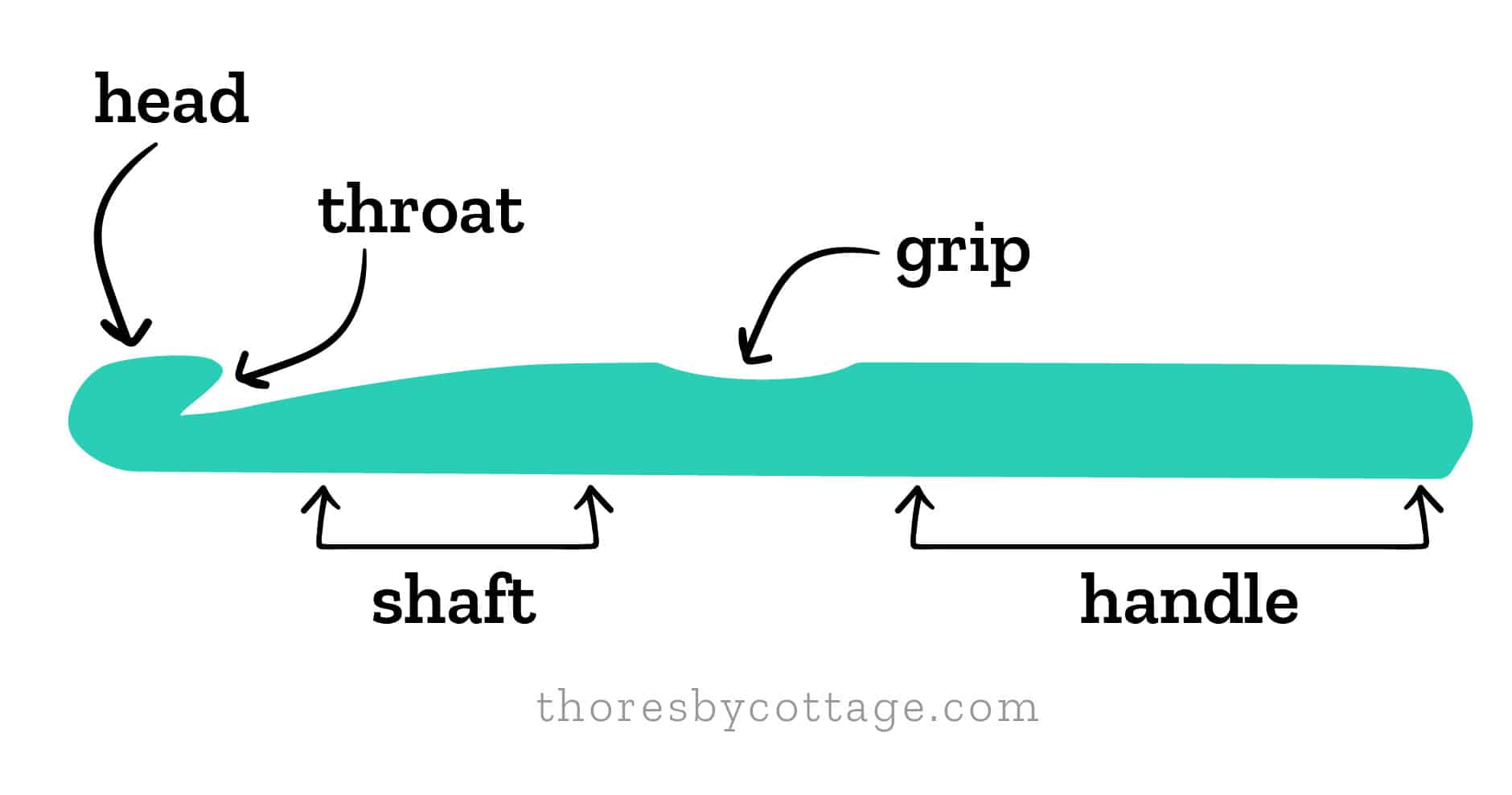
1. Head
This is the pointy end of the hook that is used to push your hook through your work to make a stitch. The heads of some hooks can be very pointy, while others can be more rounded. Pointy heads can make it easier to insert your hook, particularly into tight or small stitches, but they can also split your yarn.
2. Throat
This is the part of the hook where the yarn sits as you pull your yarn through to complete a stitch. In some hooks, the throat can be quite shallow and you risk your yarn slipping out. Other hooks have a deeper throat.
3. Shaft
The shaft lies below the head and it determines the diameter of your stitches. A thicker shaft will give you a larger stitch. This part of the hook comes under the most strain when you are crocheting a stitch.
4. Grip/thumb rest
This is the part of the hook where your thumb or finger will rest. This is often where the hook size information is stamped. Not all crochet hooks have a thumb rest.
5. Handle
Where you hold your crochet hook. Surprisingly, there is no standard length for a crochet hook handle! If the handle is too short, the hook can be very uncomfortable to hold as it will dig into the palm of your hand. If the handle is too long then your stitching can feel unwieldy. Remember that everyone has different-sized hands, so the perfect fit for you may not be the case for someone else!
There are many different types of crochet handles, including regular straight handles, rubberised handles, ergonomic (designed to fit your hand comfortably), novelty etc.
A note on inline vs tapered
In terms of shape, crochet hooks are grouped into one of two categories; inline or tapered (or in some cases, a hybrid). The shaft of a tapered hook is tapered towards the head, while an inline hook is uniform all the way up the shaft.
On a tapered hook, the head usually protrudes a little above the line of shaft, while with the inline hook the head and shaft are aligned. The throat of inline hooks also tend to be deeper and sharper than tapered hooks. Inline hooks are said to be easier to use for beginners.
Inline hooks are less readily available than tapered hooks. Susan Bates are a popular brand (inexpensive too!) if you are looking to try this style of hook.
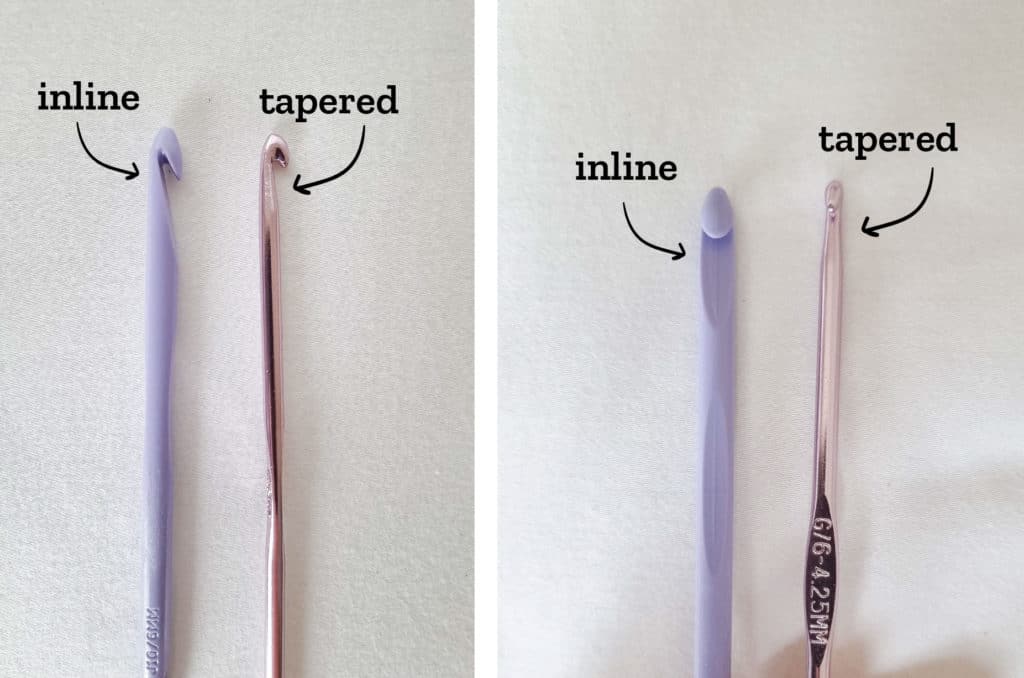
A note on ergonomic grips
Ergonomic handles can be made of a variety of different materials and are designed to make the crochet hook more comfortable to hold. However, not all ergonomic handles are created equal!
Take note if there are any ridges, bumps or grooves from the manufacturing process. If there are, they may be uncomfortable and cause blisters from rubbing against your hand or fingers. Poorer quality plastic / rubberised handles can also become sticky and unpleasant to hold.
>>Furls crochet hook review: pros and cons of ergonomic hooks
A note on pencil grip vs knife grip
Not everyone holds their crochet hook in the same way. The most common holds are the knife grip and the pencil grip. The way you hold your crochet hook may have an impact on the type of hook that works best for you. It’s always a good idea to hold a crochet hook in your hand (if possible) to see how it feels before you purchase one.
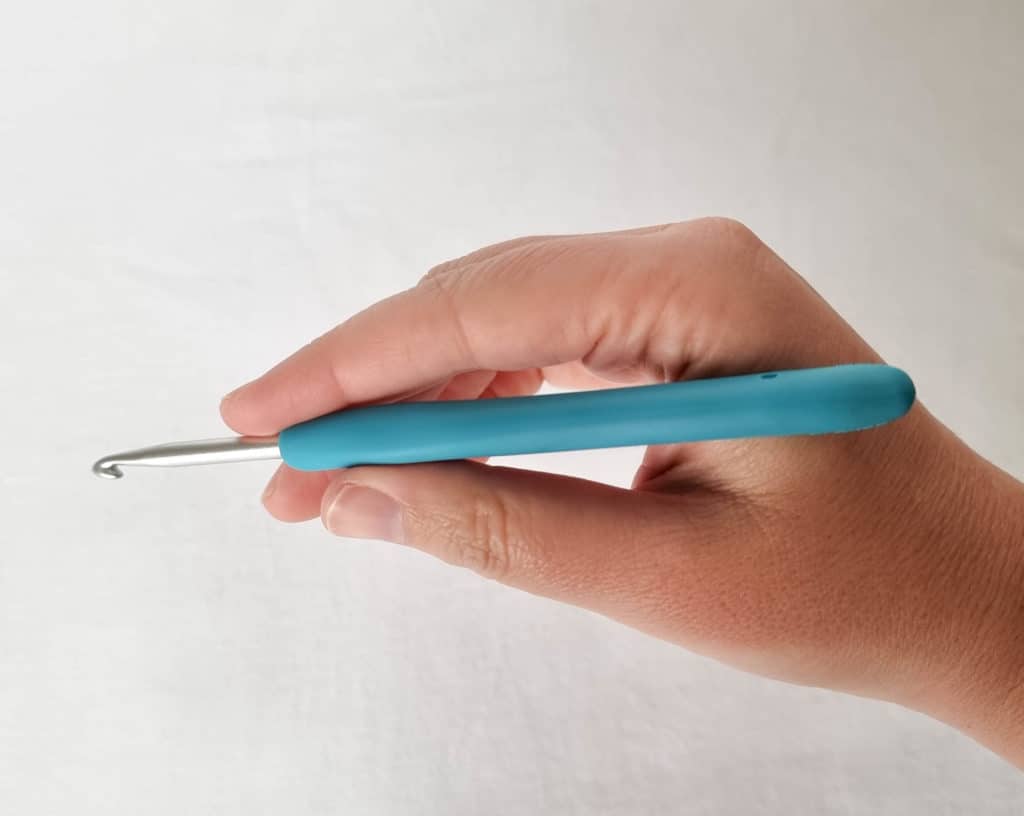
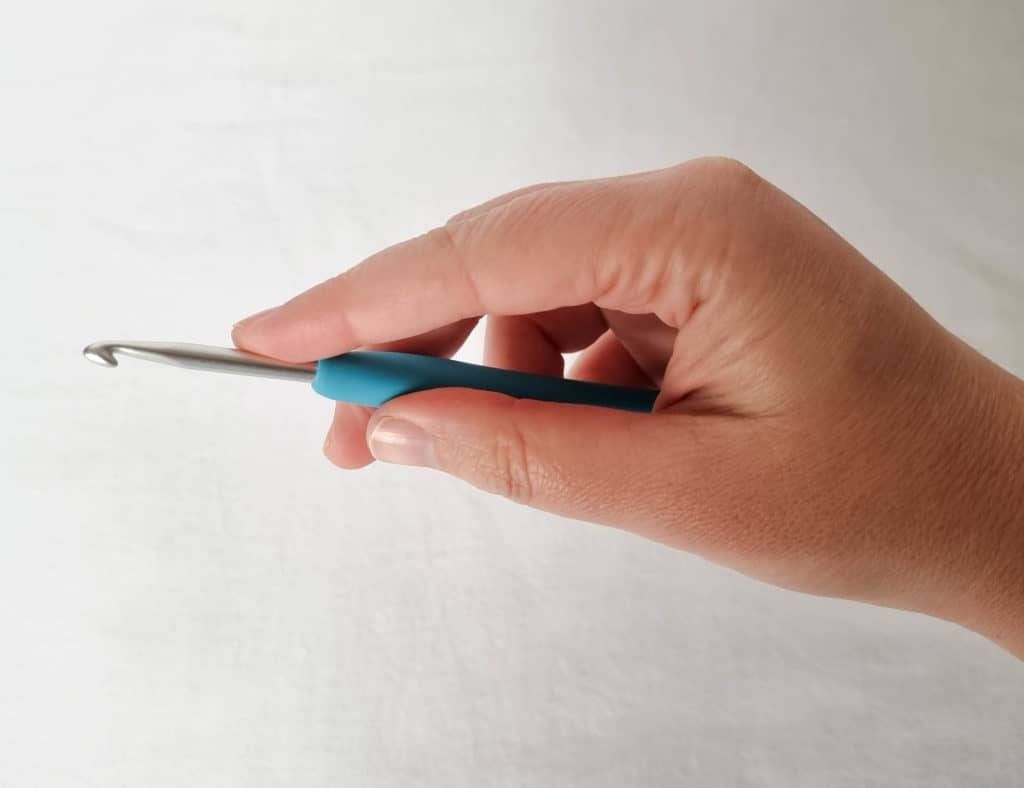
What are crochet hooks made from?
Crochet hooks can be made from a number of different materials but generally fall into 3 categories; wood, metal, and plastic.
Wood
Wood is quite a popular choice for crocheters. It is a lightweight material and is warmer to the touch than metal hooks. This is great for people who suffer with any hand pain or fatigue when crocheting.
Wooden hooks have a natural beauty as the wood grain is often visible, which also makes each hook unique. They are available at a wide range of price points, wood types and styles, from sleek and minimalist, such as the ChiaoGoo bamboo hooks, to hand carved and decorative like the Furls Alpha series.
Wooden hooks do need to be good quality – any rough spots will snag your yarn and because of the natural weaknesses inherent in wood grain, they are prone to breaking if you crochet tightly or drop them on a hard surface from a height.
Wooden hooks are also not good for crocheting small stitches or amigurumi. This is because the shaft of the hook would need to be very thin to make small stitches and will snap very easily.
Metal (Steel/Aluminium)
Metal crochet hooks are perhaps the most ubiquitous of hooks. They come in the largest range of sizes and are available worldwide. They are hard wearing and smooth which makes them fast to crochet with and an excellent candidate for small or tight crocheting, like amigurumi.
Because they are made with metal, they are generally heavier than most other hooks (although aluminium hooks are quite light) and cold to the touch, which can be uncomfortable for some.
Metal hooks are also available at a wide range of prices. Typically, simple steel hooks are cheaper, while their more glamorous cousin, the aluminium hook offers a more premium experience. Many metal hooks, such as the popular Clover Amour series, come with a rubberised ergonomic grip. I use Clover hooks and I’ve been really happy with them!
Plastic/Acrylic
Plastic crochet hooks are available in many sizes, colors and price points. From the glittery jumbo hooks to rainbow colors, there are options for every taste! Plastic hooks are generally not as expensive as wood or metal hooks, although there are premium brands which offer luxury acrylic hooks.
Plastic hooks, particularly poorer quality hooks, can have imperfections which can snag, so watch out for those. They can also snap if put under too much tension and plastic also has a tendency to squeak as you work.
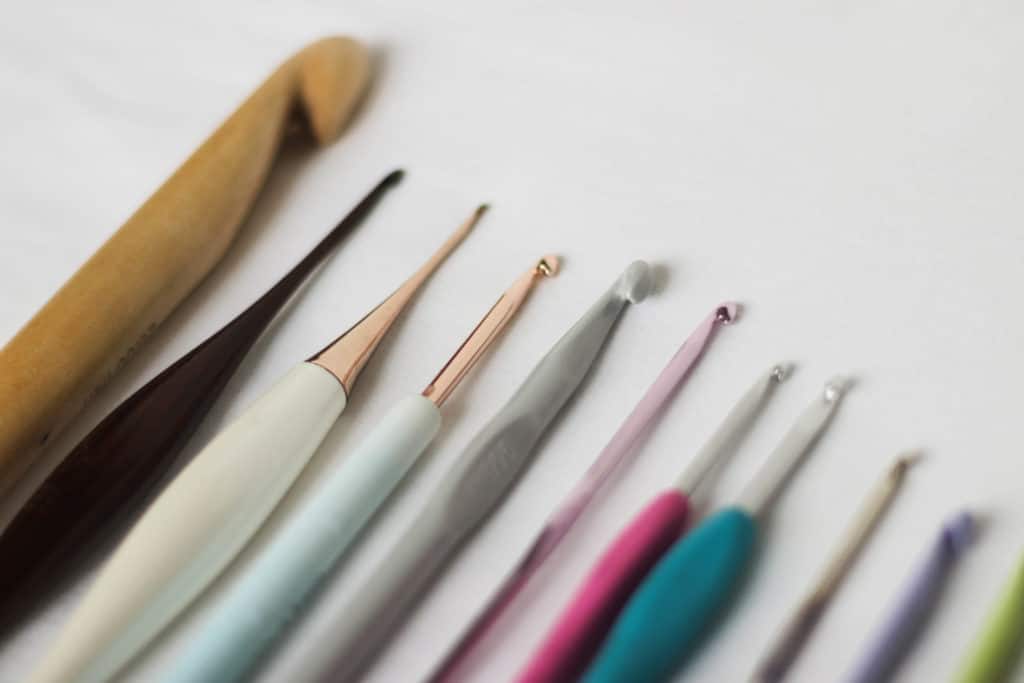
Tips for choosing the best crochet hook:
Choosing the best crochet hook can be overwhelming, particularly when faced with a wall of different options and plethora of opinions! I’ve put together a few simple questions to consider as you browse the yarn isles, to help you with making a suitable choice.
1. How does the hook feel when you hold it? Does it sit comfortably in your palm? Are there any parts of the hook that rub your hand in way (blister alert!)?
2. What material do you prefer? Metal tends to glide better through yarn, but it is heavier and colder to the touch. Wood has some resistance which is great for very slippery yarn.
3. Do you want your crochet hook to have a thumb rest or an ergonomic handle?
4. What types of yarn are you likely to use? Are they prone to splitting? If yes, then perhaps consider a hook that isn’t too pointed.
5. How tightly do you crochet? Do you need a hook that is nice and strong? If yes, then make sure to go with a metal hook.
6. Where is the hook size information recorded? Personally, I prefer the hook size to be embossed on the hook, rather than printed, so it doesn’t rub off.
7. What size crochet hook are you looking for and does the brand you use make that size? Not all brands make all sizes of hooks. And materials like wood are not suitable for small crochet (although wood is great for jumbo hooks!)
8. What is the after sales support like for the brand of hook you are purchasing (this is more relevant to expensive hooks or specialized hooks that may need replacement parts)
9. Do you want to purchase a range of sizes, or just one hook? Sometimes purchasing a set works out more cost effective per hook, and you often receive other additions like a carry case or stitch markers. Just be careful of cheap knock offs!
10. Do the hooks use standard hook sizing? If you aren’t sure, you can check with a gauge from a reputable brand (such as this one from Knitters Pride)
If you have made it to the end of this article, well done! I hope that you have found this deep dive into the world of crochet hooks helpful.
Happy stitching!

Thank you so much for this excellent information. Until today I didn’t realize there were names for the differences in crochet hooks!
Great information, but it appears you were only looking at this through the eyes of a crocheter who uses the knife grip. How do all those “ergonomic” hooks with all the humps and bumps feel in the hands of one who uses the pencil grip?
It really does depend on the hook. I would always suggest trying to hold the hook in hand before purchasing to see if it could be a good fit! Even if a hook comes highly rated, it may not be a good fit for your hand and the way you hold a hook. Some of the lumps and bumps are designed to help reduce tension in your hand (for both grip styles) but not everyone finds them comfortable.
Thank you for gathering all that data and sharing it, along with the insightful questions. I recently took up crocheting and am spending hours rewinding YouTube videos in order to grasp the hand movements for the stitches. I picked up a selection of aluminum hooks from the local craft stores, but haven’t been happy with how they go through the stitches, how often the yarn falls off my stitch, and of course, how my hand and wrist feel. I will definitely consider some alternatives out there, though I think I am going to have to save my pennies before I upgrade. Again thank you for sharing your experience with us beginners.
Thanks so much for these information about hooks as I was a week ago into a conversation of what hooks and what brand name and how do you look for the right hook and this is now an answer to many of our questions.
It can be quite overwhelming! I’m so glad this article can help 🙂